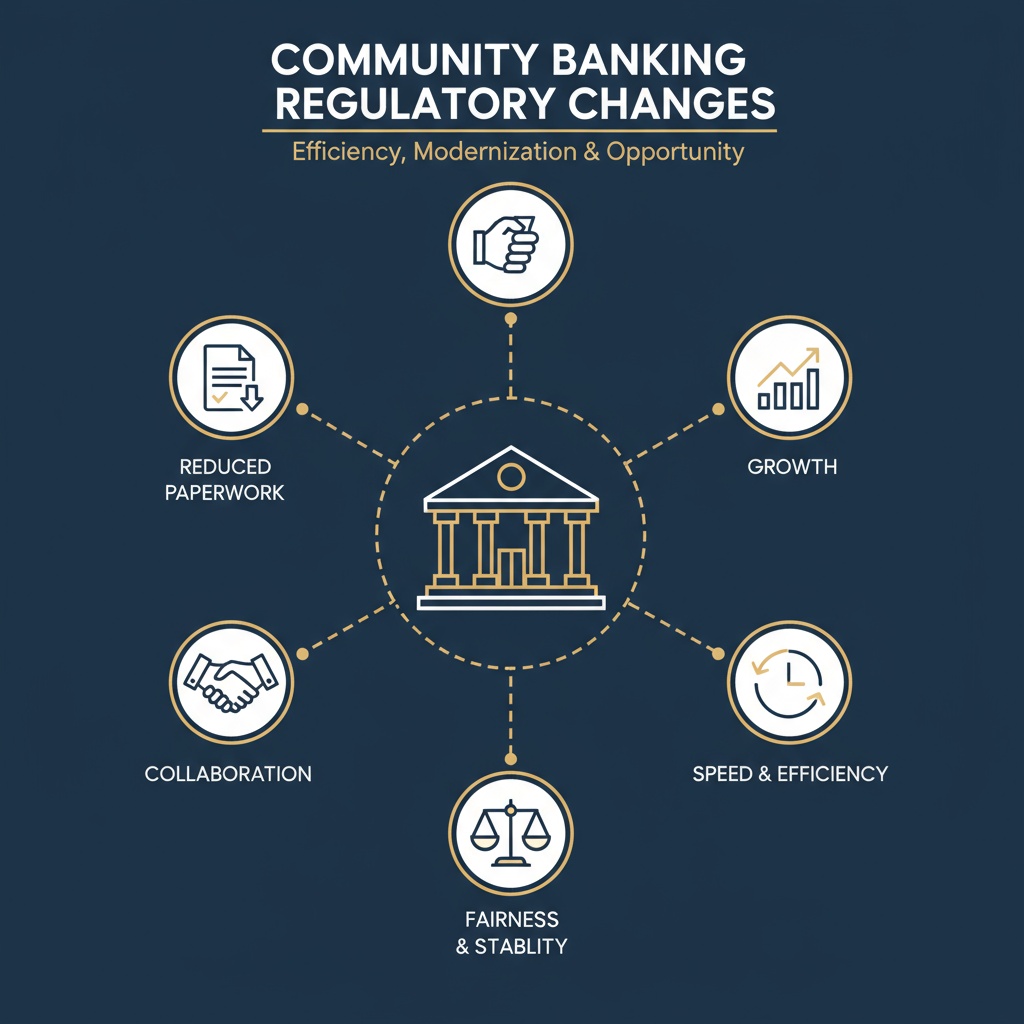 The Office of the Comptroller of the Currency (OCC) just delivered a gift to community banks across America—and it’s one that’s been a long time coming. In a sweeping announcement, the OCC revealed plans to dramatically scale back non-statutory oversight of small banks, eliminate duplicative reporting requirements, and fast-track licensing approvals for community institutions.
The Office of the Comptroller of the Currency (OCC) just delivered a gift to community banks across America—and it’s one that’s been a long time coming. In a sweeping announcement, the OCC revealed plans to dramatically scale back non-statutory oversight of small banks, eliminate duplicative reporting requirements, and fast-track licensing approvals for community institutions.
For community banks that have spent years navigating increasingly complex regulatory frameworks designed for much larger institutions, this isn’t just good news—it’s transformational.
What’s Changing?
The OCC’s new approach represents a fundamental shift in how community banks will be supervised. Here are the key changes:
Risk-Based Examination Approach
Starting January 1, 2026, the OCC will eliminate policy-based exam requirements not mandated by law. Instead of one-size-fits-all examinations, examiners will use a fully risk-based approach tailored to each bank’s size, complexity, and risk profile. This means examiners will have the discretion to conduct streamlined testing, use more limited sampling, and rely on bank-provided reports when appropriate.
Simplified Investment Product Oversight
Community banks that sell investment products like mutual funds or annuities will no longer be examined under the complex Retail Nondeposit Investment Products (RNDIP) handbook. Instead, they’ll be reviewed under more general supervisory guidelines—a common-sense change that recognizes the difference between a $5 billion community bank and a multinational financial institution.
Flexible Model Validation
Smaller banks will no longer need to conduct yearly reviews of their financial models. Banks can now decide how often to validate their models based on their size, complexity, and risk exposure. The OCC has promised not to penalize institutions that take a lighter-touch approach.
Elimination of Duplicative Fair Housing Reporting
The OCC has proposed scrapping the Fair Housing Home Loan Data System regulation, which it describes as “largely duplicative” and obsolete. The agency maintains it can still effectively monitor housing discrimination without this additional burden.
Fast-Track Licensing for Community Banks
Under a new proposed rule, community banks with clean regulatory records would have automatic access to truncated filing procedures for mergers, reorganizations, and other corporate actions—allowing them to compete more effectively within the industry.
Why This Matters for Community Banking
1. Resources Can Be Redirected Where They Belong
For years, community banks have allocated significant staff time and resources to compliance activities that were designed with megabanks in mind. The regulatory burden has been particularly acute for institutions under $10 billion in assets, where compliance costs consume a disproportionate share of operating budgets.
With these changes, community banks can redirect those resources toward what they do best: serving their customers and communities. Instead of preparing for examinations using complex handbooks designed for global institutions, community bankers can focus on relationship banking, small business lending, and community development.
2. Examiner Discretion Means Better Supervision
The shift to examiner discretion isn’t about reducing oversight—it’s about making supervision smarter. When examiners can tailor their approach based on actual risk rather than checking boxes on a standardized form, everyone benefits. A well-managed $500 million community bank with a conservative lending profile shouldn’t face the same examination intensity as a troubled institution or a complex regional bank.
As the OCC bulletin states: “When appropriate for a community bank’s activities and risk profile, examiners will conduct appropriate examination activities.” This approach recognizes that not every bank presents the same risks and that supervision should reflect that reality.
3. Competitive Advantage in the Market
The fast-track licensing provisions could be a game-changer for community banks looking to expand, merge, or reorganize. In an industry where timing matters—whether it’s seizing a market opportunity or responding to competitive pressure—the ability to move quickly through regulatory approvals provides a real competitive advantage.
For community banks competing against larger regionals and national institutions, this levels the playing field in a meaningful way.
4. Focus on What Actually Matters
By eliminating requirements like annual model validation reviews and complex investment product examination procedures, the OCC is acknowledging a simple truth: not every regulatory requirement designed for the largest banks makes sense for community institutions.
A community bank using straightforward loan pricing models doesn’t need the same validation rigor as a bank engaged in complex derivatives trading. A community bank offering basic mutual funds through a third-party program doesn’t need examination procedures designed for institutions with proprietary investment products.
The Broader Context
This regulatory relief comes at a critical time for community banking. Consolidation continues to reduce the number of community banks, and regulatory burden has been cited as a significant factor in merger decisions. Many community bank CEOs have pointed to compliance costs as a key challenge in remaining independent.
The American Bankers Association’s response to the OCC announcement captured the sentiment well. ABA President Rob Nichols called it “common sense,” noting that the changes “will help ensure that individual institutions are subject to supervision that is appropriate to the risks presented by their products and services.”
What This Means Going Forward
The OCC has indicated that community bank reforms are a priority, with ongoing work including adjustments to the community bank leverage ratio framework and a simplified strategic plan process for Community Reinvestment Act compliance.
For community banks, this represents an opportunity to:
- Reduce compliance costs and redirect resources to revenue-generating activities
- Streamline operations without sacrificing safety and soundness
- Compete more effectively with larger institutions
- Focus on relationship banking rather than regulatory box-checking
- Pursue growth opportunities with faster licensing approvals
The Bottom Line
The OCC’s regulatory overhaul isn’t about eliminating oversight or compromising safety and soundness. It’s about recognizing that community banks are fundamentally different from the largest institutions in the financial system—and that regulation and supervision should reflect those differences.For community banks that have long argued they shouldn’t be regulated like JPMorgan Chase, this is a validation of that position. For the communities these banks serve, it means their local financial institutions will have more resources to dedicate to meeting local needs rather than navigating regulatory complexity designed for global banks.
This is what smart regulation looks like: tailored, risk-based, and focused on what actually matters for the safety and soundness of individual institutions and the financial system as a whole.
The question now is whether other regulators will follow the OCC’s lead in recognizing that one-size-fits-all regulation doesn’t serve community banks—or their communities—well.
